This was one of the most requested post on the blog, after I did my top 15 indoor plants blogpost. Every year spring-time (September in NZ), I repot all my house plants. It’s a once a year job that gives new life to my plants and has them growing & flourishing year after year. I’ve been doing this for 6 years now so I qualify to write this post.
What’s Repotting?
It's exactly what it sounds like. Putting the plant in a new pot.
I inspect the plant, take it out of its current pot, loosen the roots, wash the pot with warm soapy water, plant the root ball in fresh new soil, fertilise if necessary and remove any dead spent leaves, before putting the plant back inside the house.
Why Repotting?
Unlike outdoor plants which can suck up nutrients from the deep, indoor plants depend on the little soil they are in for survival. Hence, giving them fresh, nutrient-dense soil each year gives them a growth boost.
As plants grow bigger, the current pot size might be too small for them. When you notice roots coming out from the bottom of the planter, it’s a sure sign that the pot size needs to be upgraded. Such plants are called pot bound and absolutely need to be shifted to a new bigger pot for them to keep growing as they want to.
When to Repot?
Once a year is sufficient. I prefer to do it in spring because the growing season is about to start and this gives fresh soil gives the plant a growth boost. Also, better chances of survival as changing soil etc is a shock to plants system. Imagine someone uprooting and planting/putting you in a completely new setting. It’s a shock to the system. If done during unfavourable times (like winters), it will take you a lot of time to recover/overcome. So repotting is best done in the favourable spring season. This will be Feb/March in Northern Hemisphere.
How to Repot?
It’s a fairly straightforward process, but when you have a lot of indoor plants, it can be one big Sunday afternoon job.
 |
| Buy the best quality potting mix you can afford |
 |
| If using generic potting mix (cheap one), consider adding soil conditioner, liquid fertiliser or fertiliser pellets. Any one of these. |
 |
Things needed-
- An open space
- Some form of ground cover if needed (I re-used some plastic packaging)
- A footstool for you to sit on or soft padding under your knees
- Gloves
- Face mask (because bagged soil is a health hazard. Always keep your nose and mouth away while opening a bag of potting mix/soil. The bacteria/spores inside have been known to cause fatalities when the soil that is too old or stored in improper conditions is inhaled.
- Good quality potting mix (the best you can afford)- I’m using Dalton’s. It’s worth spending a little extra on the potting mix because the good quality ones tend to have added fertiliser, compost, wetting agents, etc. This Dalton's bag says the added fertiliser would last 9 months. So basically I’m pretty much sorted till next round of repotting a year later. Using an expensive mix saves you from buying added fertiliser.
- Indoor plant fertiliser/seaweed soil conditioner/ etc.- if you are using generic soil or potting mix, it’s best to supplement it with nutrients. I highly rate these 3.
- Assorted pot sizes
- Bucket of warm soapy water- I use a mild eco-friendly dishwasher (so I can discard muddy water in the garden later)
- Scissors to clip dead leaves
- A cloth to clean and wipe off plants before they go back in the house
Caution: Follow instructions on fertiliser packaging regarding quantity to mix. Over-fertilising is an overload on the plant’s system and can burn leaves and even kill a plant.
As my potting mix has added fertiliser, I did not add any. However, I did water the plants after I finished repotting with water that had a trace amount of this Yates Fish & Seaweed soil conditioner mixed in.
After 6 months or so, when the plants have used up some of the fertiliser, I will nourish them with some diluted liquid indoor plant's fertiliser. I do this just once a year.
So in summary, I repot all my plants once a year and I give them a dose of liquid fertiliser once a year (6 months or so after repotting). That is all the care I do. Because as I mentioned in my top 15 plant tips here, plants thrive on neglect. Over-Care (over-watering) is a sure killer!
The Process of Repotting
 |
| Wash your planters with warm soapy water |
 |
| Go up a planter size if the plant is pot-bound (roots coming out of drainage holes at the bottom) |
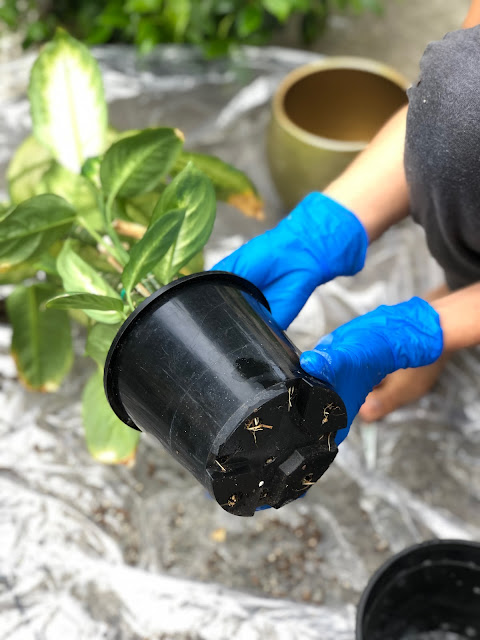 |
| This plant is pot-bound (roots coming out from bottom) |
 |
| Remove the plant from old planter |
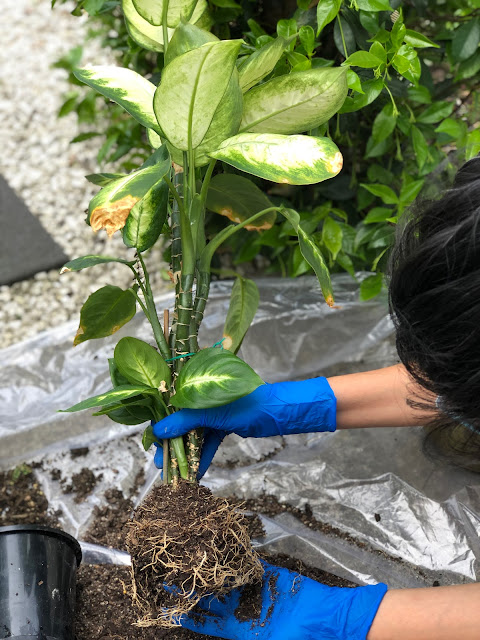 |
| Loosen the roots; shake off excess soil from root ball; trim roots if needed. |
 |
| Leave some old soil on root ball (as pictured) |
 |
| Add potting mix to the new planter; Add fertilising pellets if using a generic or low quality potting mix |
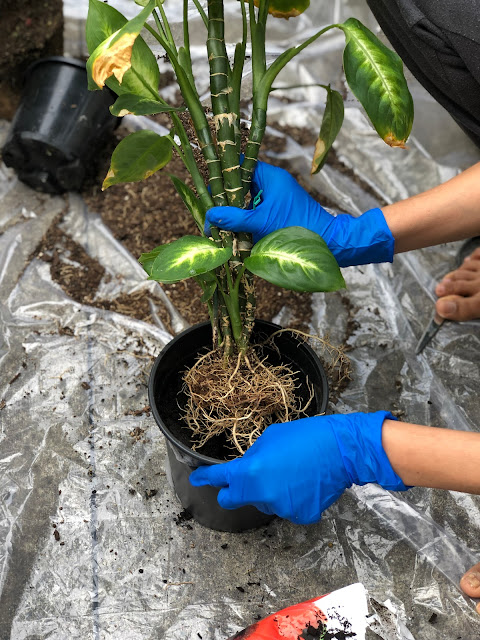 |
| Put the plant into new planter |
 |
| Add stakes if the plant needs support. Add more potting mix. |
 |
| Plant is ready |
 |
| If available, dilute some soil conditioner in water and feed the plant (optional). Plain water is fine too. |
 |
| Wipe the plants clean; check for bugs; remove nay spent/dead leaves |
 |
| Repeat for all indoor plants |
 |
| Discard the old soil in a garden bed or elsewhere as appropriate. |
- Water your plant a little so the roots and soil are packed and the plant can slide out of its planter easily.
- Remove the plant from its planter (all planters must have drainage holes)
- Shake off old soil and loosen up the roots. You can even prune some roots if they are getting out of control.
- Leave little soil on roots. Don’t make them bare, or the plant with be shocked with a completely new soil medium. This can halt plant growth for a while.
- Wash the planter with warm soapy water followed by freshwater. This kills any germs and also prevents cross-contamination between plants, in case you re-use the planter for a different plant.
- If the plant is pot-bound like this Dieffenbachia here, the planter size needs to be upgraded. This will need to go to a bigger sized pot. Hence, it’s a good practice to keep saving different planter sizes you come across during the year. I’ve never had to buy my own. Just keep saving the ones other plants come in.
- If the plant didn’t take up much space in the old planter and still has room to grow, simply re-use the old planter after washing.
- Add a layer of fresh soil in the planter
- Add some fertiliser pellets in if your potting mix doesn’t have it added already. It’s a good practice to not have the fertiliser touch the roots directly as it can burn them. Add more soil to cover fertiliser.
- Put the plant in, add more soil, tap the plant on the floor to make sure soil settles in. Add more soil if needed
- Add stocks/support if necessary. Best to add them with the root ball. It’ll be more stable.
- Remove any dead spent leaves
- Check the plant for any diseases. Mealybugs are the worst and I often find them hiding in stem crevices while repotting. Remove bugs. Use bug spray if necessary. Make sure the bug spray is approved for indoor plants.
- Water the plants. Add some liquid soil conditioner if necessary. This is not required if your potting mix is good quality with added nutrients.
- Clean the plant and leaves.
- Job done for another year!
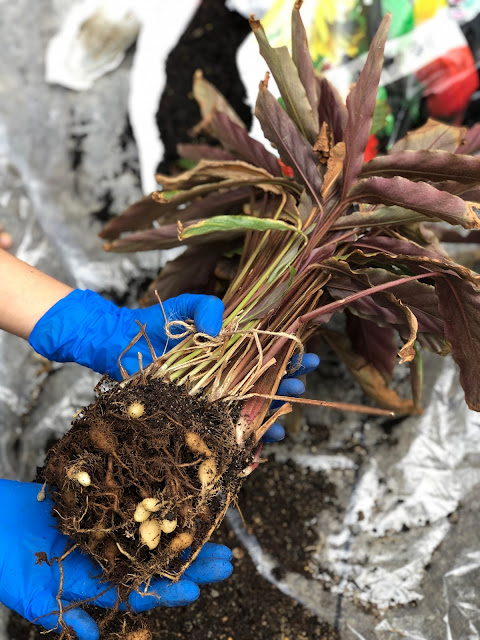 |
| Repotting Calathea. |
 |
| Repotting Anthurium. I trimmed some roots for this one as they were quite dense and wouldn't fit in the planter. |
Aiza loved helping mum too.
I'm happy to answer any repotting or plant care questions you might have? Do you want me to write more about plants and gardening? Talk to me in the comments below.
Love
Nishu



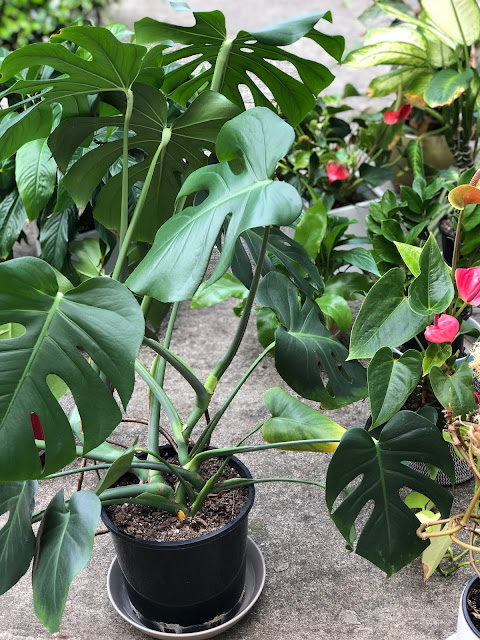






Post a Comment